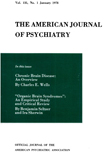THE PROBLEM OF DIAGNOSIS IN PARANOIC DISORDER
Abstract
The purpose of this article has been three-fold: (1) to call attention to the deplorable situation regarding the reluctance of most psychiatrists to diagnose paranoic disorder where such a diagnosis is clearly indicated; (2) to affirm that the confusion between paranoic disorder and paranoid schizophrenia, where it exists, is largely unnecessary; and (3) to render differential diagnosis of these two psychoses more certain and accurate by the addition to the classical symptomatology of several sociogenic, psychogenic, and associative trends that occur in these psychoses with high statistical frequency. Thus in addition to the well-known symptoms, the paranoic patient is found to have grown up in an atmosphere of suppression, harshness, hostility, and frequently of brutality. The paranoid schizophrenic is less likely to have been reared in this type of home. Diagnosis should take into account, furthermore, the prepsychotic personality of the patient. The diagnostic value of the prepsychotic personality, in our judgment, has been insufficiently recognized by diagnosticians and psychotherapists. The same observation obtains in regard to the other factors that we have briefly described.
On the basis of our clinical and biographical data we believe strongly that, if all the crucial experiences in the life history of a patient were known, we would find no sharp breaks between the prepsychotic and the psychotic make-up of the individual. It is universally recognized by clinicians and competent investigators that paranoic psychosis has a slow and insidious onset. The onset in only 2 cases in our group of paranoic disorder is described as sudden or acute. Interestingly enough there was sharp disagreement among the examining psychiatrists concerning the diagnosis of these cases. The factor of age alone clinched the decision! This factor is a tenuous basis for differential diagnosis in the face of the type of rich case material to which we have called attention. Given full knowledge of the paranoic's family setting, his successes and failures, the trend of his dominant emotional and intellectual strivings, his conception of himself in his own eyes and, as he believes, in the eyes of others, we are able not only to make a more adequate diagnosis of the patient but to predict the possible outcome of his adjustment to the whole vast complex of his interpersonal relations.
Access content
To read the fulltext, please use one of the options below to sign in or purchase access.- Personal login
- Institutional Login
- Sign in via OpenAthens
- Register for access
-
Please login/register if you wish to pair your device and check access availability.
Not a subscriber?
PsychiatryOnline subscription options offer access to the DSM-5 library, books, journals, CME, and patient resources. This all-in-one virtual library provides psychiatrists and mental health professionals with key resources for diagnosis, treatment, research, and professional development.
Need more help? PsychiatryOnline Customer Service may be reached by emailing [email protected] or by calling 800-368-5777 (in the U.S.) or 703-907-7322 (outside the U.S.).



